Born in the South Bronx to Puerto Rican parents, artist and writer George Pérez (1954–2022) cut his teeth in the 1970s as an artist at Marvel who worked on lesser titles like
The Deadly Hands of Kung Fu and
Creatures on the Loose, and then mainstays like
Fantastic Four and
The Avengers. In the 1980s, Pérez jumped ship to DC where he helped turn
The New Teen Titans into a top-selling title and cocreated
Crisis on Infinite Earths, which marked the publisher’s fiftieth anniversary and consolidated its sprawling universe. As writer and artist, Pérez relaunched DC’s
Wonder Woman, a run that later inspired much of the 2017 film.
Though Pérez’s style is highly recognizable, his contributions to comic art and history have not been fully acknowledged. In
George Pérez, author Patrick L. Hamilton addresses this neglect, first, by discussing Pérez’s artistic style within the context of Bronze Age superhero art, and second, by analyzing Pérez’s work for its representations of race, disability, and gender. Though he struggled with deadlines and health issues in the 1990s, Pérez would reintroduce himself and his work to a new generation of comics fans with a return to Marvel’s
The Avengers, as well as attempts at various creator-owned comics, the last of these being
Sirens from Boom! Studios in 2014. Throughout his career, Pérez established a dynamic and minutely detailed style of comic art that was both unique and influential.
Circa l’autore
Patrick L. Hamilton is professor of English at Misericordia University in Dallas, Pennsylvania. With Allan W. Austin, he coauthored All New, All Different? A History of Race and the American Superhero, which won the Popular Culture Association’s John G. Cawelti Award for the Best Textbook/Primer. He also authored Of Space and Mind: Cognitive Mappings of Contemporary Chicano/a Fiction.












